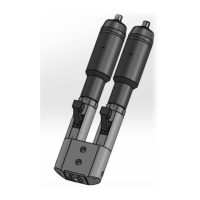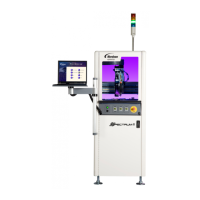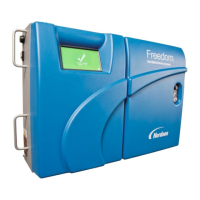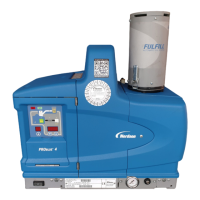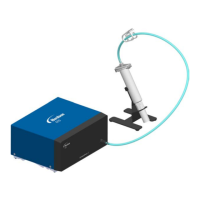G-4 Glossary
Pattern Recognition System: A vision system that
finds workpiece fiducials to reliably locate dispensing
sites and compensates for minor workpiece
misalignment during dispensing.
Personal Protective Equipment (PPE): Clothing and
Equipment worn to reduce the risk of personal injury
from hazards associated with operation, maintenance,
and servicing of the dispensing system. This includes
the wearing of rubber gloves and safety glasses.
Pneumatic Devices: Air pressure actuated devices such
as Stop Pins, Clamp Bars, and Lift Tables.
Port: A hardware interface on a computer to which you
can connect a device. An opening in a mechanical
device such as the vacuum port in a contact heater or the
Conveyor port on the dispensing system.
Post-Dispense Station: The part of the dispensing
chamber where a workpiece is held after it leaves the
Dispense Station and before the workpiece leaves the
system. The part may be heated in the Post-dispense
Station, but no dispensing is performed.
Power Manager: The Power Manager is located inside
the rear cabinet and houses the Main Circuit Breaker
and the Main Power Inlet. It also contains the EMO
circuitry. The EMO button, the green ON (I) button, and
the black OFF (0) button are directly connected to the
Power Manager.
Precision Fluid Air Gauge and Regulator: The
Precision Fluid Air Gauge and Regulator controls air
supplied to the fluid syringe.
Pre-Dispense Station: The part of the dispensing
chamber where a workpiece is held before entering the
Dispense Station. The workpiece may be heated in the
Pre-dispense Station, but no dispensing is performed.
Production Shutdown: When all dispensing has been
stopped under non-emergency conditions such as the
end of a shift.
Psi: Pounds per Square Inch (lbs/in
2
). English unit of
pressure measurement.
Pump: See Dispensing Valve.
Purge Station: A location at the front of the dispensing
chamber where the outer diameter of the dispensing
needle is cleaned and the Dispensing Valve is
automatically purged at user-defined intervals. A
disposable plastic cup inside of the Purge Station
catches the dispensed fluid.
PWA: Printed Wiring Assembly. The completed PWB
with electrical components installed. Also known as a
printed circuit board assembly (PCBA).
PWB: Printed Wiring Board. An insulating board
containing conductive tracks for electrical circuit
connections on which chips and other electronic
components are placed.
Rapid Response Heaters: Rapid Response Heaters
with low-mass design rapidly ramp to temperature for
uniform material flow and quick cool-down for fast tool
change out. An advanced hole pattern provides highly
uniform impingement heat across the entire part surface.
Regulator: Device for controlling the amount of air
pressure supplied to a pneumatic system.
Reticle: A group of lines, circles, angles, or other
pattern used as a measuring reference, as a focusing
target, or to define a camera field of view.
RTD: Resistive Temperature Detector. A highly
accurate temperature sensor consisting of a coiled thin
platinum wire covered in ceramic material and encased
in a 1/8-inch stainless steel tube. Found in Needle
Heaters, Heater Tooling, and some Dispensing Valves.
Used in place of a thermocouple.
Safe Z-Height: Safe Z Height is the height below which
the tip of dispensing head cannot go when moving from
one set of coordinates to another during operation.
SCFM: Standard Cubic Feet per Minute. A unit of flow
of a liquid or gas.
SECS/GEM: SEMI Equipment Communication
Standard (SECS), SEMI Generic Equipment Model for
Effective Factory Automation (GEM). SECS/GEM is
the protocol used for linking several factory equipment
units together via a host computer. The GEM standard
defines useful conventions for designing the
communications interface on a unit of factory
equipment to improve operations with a host computer.
SEMI: Semiconductor Equipment and Materials
International. An organization that defines protocols for
the semiconductor industry.
Service Shutdown: When all dispensing is stopped and
the dispensing system is made safe so that servicing can
be performed.
Service Station: The Service Station consists of a
needle vacuum purge cup, on-board high precision
scale, and a needle calibration substrate.
Service Technician: Trained personnel responsible for
performing advanced system servicing procedures.
SMA: Surface Mount Adhesive. An adhesive used for
attaching chips to PWBs.
SMEMA: Surface Mount Equipment Manufacturers
Association. Established protocol for signal
communication between two or more different systems.
Substrate Heaters: A contact or impingement heater
tooling plate located between the conveyor rails. These
heaters can be located in up to three conveyor stations
(pre-dispense, dispense, and post-dispense). Used to
heat workpieces to control the flow and cure time of
dispensed fluid.
SVGA: Super Video Graphics Array. A video card that
produces high-quality color images at high resolution.
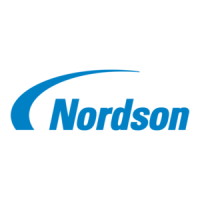
